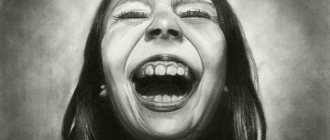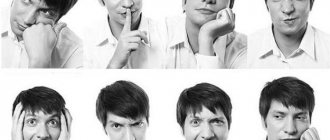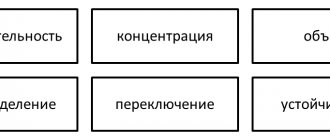Behavior can tell a lot about a person, his character, preferences, and characteristics of interaction with other people. Therefore, each psychological theory sought to give its own definition of behavior and find a way to describe the factors that influence it. It would hardly be advisable to describe each approach, but the main psychological theories of human behavior can give you interesting information about how followers of different schools see it differently.
In this article:
BehaviorismPsychoanalysisHumanistic psychology
Psychology of behavior: definition of the concept
Behavioral psychology is a field of knowledge that connects a person’s actions with his psychological characteristics. We can say that the actions and reactions of an individual visible to others reflect his inner world.
Familiarity with this area of knowledge of psychology makes it possible to draw a psychological portrait of an individual based on the actions and deeds of an individual, and draw conclusions about his character traits or intentions. Knowing what a particular person is like, you can predict her actions in certain situations.
It is important to understand that the concept of “behavior” includes absolutely all manifestations and characteristics of human activity. This concept includes actions in relation to:
- to other people;
- to things;
- to yourself;
- to animals and nature;
- to situations;
- etc.
When assessing the behavioral characteristics of an individual, attention is paid to:
- gestures: speed and direction of movements of arms and legs, body position, tilts and turns of the head, gait, posture;
- facial expressions: movements of the facial muscles, including a smile, gaze, movement of the eyebrows and frontal muscles;
- emotions: speed of occurrence, appropriateness of reaction, strength and methods of manifestation;
- voice: speed of speech, timbre and pitch, tone, sudden hoarseness, etc.
Knowing the language of gestures and facial expressions, they can be perceived as messages about the internal motives of the interlocutor. Based on this assessment of various behavioral manifestations, we can draw conclusions about the following things:
- is the interlocutor telling the truth or lying;
- whether his intentions are serious;
- is he happy here and now;
- attitude towards the topic of conversation and the speaker;
- mood;
- is the individual confident or shy, etc.
To draw correct conclusions about a person, you need to analyze her actions in a complex manner.
The meaning of such an analysis is based on the complexity of the human personality: it is a symbiosis of the physical and mental. These parts are inseparable. And what a person feels or thinks will unconsciously affect his actions: more or less depending on the level of self-control.
And since physiologically people are still very similar to each other, their reactions to similar stimuli will also be similar in many ways.
There are many psychological schools and directions and they substantiate this relationship in different ways. Some say that human actions in various situations are influenced by biological factors: genetically determined innate physiological characteristics (reaction speed, its quality). Others believe that behavior is simply an element in the stimulus-response chain. And most of these ligaments in an adult are not congenital, but acquired.
You need to understand that each person is individual and it is easiest to judge the motives of people you know well by their actions.
Books on behavioral psychology
The following works will help you find solutions to problems that have arisen and evaluate the behavior of people around you.
- R. Cialdini, “Psychology of influence. Convince. Make an impact. Defend yourself." The book contains 6 basic principles of behavior. This book about human psychology based on behavior and gestures can be read online or in the classic version.
- T. Seelig, “Make yourself. Advice for those who want to leave their mark." Emerging tasks are incentives for further movement forward. So says the author of this book.
- S. Covey, “The Seven Habits of Highly Effective People.” A guide aimed at learning to manage your own life.
- D. Myers, “Games People Play. People who play games". Another guide to behavioral psychology research.
- M. Goulston, “Mental Traps at Work.” This book about human psychology based on behavior and gestures presents information that reveals the concept of mental traps and indicates ways to eliminate them within the framework of communication.
Understanding behavioral psychology is the key to understanding your interlocutor. In addition, knowledge of this direction helps to hide one's own emotions by controlling behavior. Studying the psychology of deception helps to identify duplicity, lies, and not to succumb to manipulation.
IMPORTANT! Informational article! Before use, you should consult a specialist.
Individual characteristics of human behavior
Not everyone can assess the individuality of a stranger and draw correct conclusions about his character based on his actions. This is probably not 100% accessible even to a professional. Because despite some common physiological characteristics, all people have different life experiences.
Thus, sudden alertness during a conversation does not always mean that the reason is in the topic under discussion and the interlocutor’s reaction is conscious. It could be a completely different third-party factor.
If the experience of each individual is unique and it is not so easy to draw conclusions about his picture of the world, then with the biological component everything is a little simpler. Numerous studies make it possible to classify people into groups according to various criteria. This simplifies the assessment task.
Human Temperament
The most popular classification of temperaments in this area. The grouping criteria are the following physiological characteristics of a person:
- speed, strength, pace of mental processes and reactions;
- level of excitability and inhibition of the nervous system.
Three areas of manifestation of temperament can be distinguished:
- General activity: determined by the intensity of human interaction with the social and natural environment. Varies from apparent lethargy and passivity to activity and quickness of action.
- Motor and motor activity: reflects the speed and sharpness of movements, tempo of speech. It is also described through talkativeness or silence, mobility or slowness.
- Emotionality is expressed by how quickly the emotional state changes and the level of susceptibility to emotional stimuli.
Depending on the combination of these characteristics in a particular person, 4 types of temperament are distinguished:
- Choleric is passionate, fast, impetuous, but with unbalanced nervous processes, quick and sudden mood swings.
- A sanguine person is mobile, with active facial expressions, lively and hot, with frequent mood swings, but with a balanced nervous system, unlike a choleric person. Productive if he enjoys his work and is cheerful.
- A phlegmatic person is stingy in expressing emotions and feelings, calm and unhurried, persistent in work, but calm and balanced.
- A melancholic person is easily vulnerable, constantly worries about various events and does not control his feelings.
The actions of an individual are also strongly influenced by his character, motives and attitude towards people, which is also the result of upbringing and the influence of society.
How to determine a person's psychotype?
The Swiss C. G. Jung became the first creator of the classification of psychotypes, which laid the foundation for the science of personality - socionics. The interaction of an individual in society is based on theories of other teachings about human behavior.
In total, the scientist identified eight types. Socionics has identified 16 types, taking as a basis two areas of personality: introverts and extroverts. The first ones have the following names and characteristics:
✔️Logical-intuitive. Doesn't like empty talk, communicates in essence. Uses logic or intuition to answer questions.
✔️ Intuitive and logical. He is careful in decisions, weighing the pros and cons, and does not take risks. Loves comfort and tranquility in everything.
✔️Logical-sensory. Pedant and realist.
✔️ Sensory-logical. Punctual, honest, sensitive.
✔️ Ethical-intuitive. A good friend who empathizes and gives advice has the qualities of a nurturer.
✔️ Intuitive and ethical. He feels people and can win them over. Likes to look good and relax.
✔️ Ethical-sensory. He doesn’t let strangers into his soul, he stands up for his family.
✔️ Sensory and ethical. He tolerates routine calmly, does not conflict, appreciates attention and care.
The second direction has the same names, but with an extraversion bias.
✔️Logical-intuitive. Soberly assesses circumstances, which does not interfere with risk. Able to not succumb to provocations, strictly following his goal.
✔️ Intuitive and logical. He does not like monotony, he is full of new ideas, bringing them to life.
✔️Logical-sensory. He is caring and sociable with loved ones, but sometimes stubborn. Perhaps this helps to always finish what you start.
✔️ Sensory-logical. A born winner at any cost. Tends to subjugate.
✔️ Ethical-intuitive. An emotional and persistent personality, he calculates everything in advance.
✔️ Intuitive and ethical. Thanks to his powers of observation, he senses people's moods. Will support you in difficult times.
✔️ Ethical-sensory. He has influence over people, but is also capable of self-sacrifice.
✔️ Sensory and ethical. Knowing how to manipulate people, he hides his true nature so that it will not be used against him.
The given characteristics are very relevant in our time, they help to identify problems in society.
Human behavior in a dangerous situation
How a person acts is very much determined by the circumstances of a particular situation. If an individual is in a familiar environment, then conscious stimuli will prevail in his actions. While danger and emergencies awaken primitive instincts and reactions.
People at such moments are often little able to consciously control their actions.
Mental disorders and behavior of people caught in an emergency zone are caused by two groups of factors:
- Factors of direct threat to physical health and life: explosions, building collapses, radioactive contamination, fires and other consequences of disasters and natural disasters. The combination of physical damage, painful shock and fear provokes mental disorders.
- Conditions for lack of information: ignorance of the scale of the disaster and lack of reports about the fate of relatives and friends. Here, mental state disorders are not associated with physiological damage, but can cause them.
Depending on the stage of the emergency, a person may experience behavioral disturbances of various types.
Violations by stages of emergency
In the first 5 hours of a natural disaster, people, as a result of the resulting stress, may first experience fear, panic, confusion, stupor of varying degrees, and a lack of understanding of the meaning of what is happening. A person’s consciousness, moral norms and restrictions are turned off, he is guided by instincts: first of all, self-preservation.
Characteristic manifestations of stress are:
- Speeches. An increase in tempo, strength and sonority, and hesitation is present, is observed with a normal type of fear reaction, and fragmentation, meaningless phrases or a complete absence of speech are observed with a complex one.
- In memory. The victim seems to unconsciously defend himself from all the horror of the situation and then can barely remember what happened and how;
- Perception of time: a few minutes seem like an eternity;
- Motor. With a simple reaction of fear, movements are concentrated, forces are mobilized to the maximum, and with pathological complex reactions - from panicked flight to complete numbness.
Also characteristic is a narrowing of consciousness and self-removal from the terrible reality, there is selectivity of behavior and impaired ability to independently make rational decisions.
At the stage of rescue operations, people often already experience fatigue and increased fatigue, turning into depression. Psychoses and neuroses are often present here.
The following psychoses can be observed in victims:
- Acute shock: stupor or flight, confusion of speech and consciousness.
- Reactive subacute:
- psychogenic depression - a state of depression turns into depression;
- hysterical depression - hysteria is replaced by depressive syndrome;
- paranoid psychosis – anxiety, restlessness, delirium;
- paranoid-halucinative syndrome - anxiety and restlessness are intensified by hallucinations;
- puerilism syndrome - stress manifests itself in the form of exacerbation of childish behavior.
During the period after evacuation, the following disturbances occur in people's behavior:
- Avoidance symptoms – a desire to distance yourself mentally and physically from memories of a natural or other disaster that has occurred, including avoidance of people, places, conversations and activities associated with it;
- psychological discomfort from the attacking flow of memories, emotions and images associated with the emergency;
- inhibition of emotions and reluctance to engage in favorite activities;
- a feeling of alienation from people or, on the contrary, dependence;
- increased unconscious reflexes: hypervigilance, readiness to defend (increased “Hit and Run” reaction)
- sleep disturbance, irritability, outbursts of anger;
- memory impairment and depression.
When communicating with such people, you should take into account that these deviations will be reflected in behavior. But this is a normal reaction of normal people. Therefore, if possible, you should not treat them as sick. and we need to show maximum understanding in order to return the victims to society.
Personality formation - advice for parents
Many people are interested in the question of whether character changes. Indeed, personal qualities are formed and change throughout life. The process begins in early childhood. The first individual traits of a child appear already in preschool age; parents can identify a certain way of behavior and attitude towards the world.
If you want to raise your child with a strong personality, to develop perseverance, courage and endurance in your child, involve him in group games with a certain plot and rules.
How to build character and teach a child to work and responsibility? From childhood, assign simple tasks to your child, gradually complicating them. Thus, the child develops discipline, self-control, behavior is determined, and the baby learns to evaluate his actions and decisions. Thus, self-education occurs.
A new stage in personality formation begins when a child enters school, when his ability to communicate with classmates and perform new responsibilities is demonstrated. As a result of a change in environment and lifestyle, the child develops organization, accuracy, and hard work.
It is important! In childhood, the personality of the baby is influenced by the character of the parents and their habits. At school, the main role in character development is played by the school community - classmates, teachers.
A child’s character is revealed through the following areas during school:
- organization and systematicity;
- determination and perseverance;
- accuracy and hard work;
- discipline;
- consciousness of duty and responsibility to the school community;
- collectivism and camaraderie.
In adolescence, personal characteristics develop most actively, because at this age the child is attracted to adult life, and higher demands are placed on him. Feelings such as duty, responsibility, participation in the collective life of the class manifest themselves more consciously.
It is possible to change a child's character. Psychologists note that there are no children whose personal characteristics could not be re-educated. However, the process requires the participation of a specialist who can identify character flaws and select the most effective strategy for further action.
Psychological properties of the crowd
In this case, a crowd means not just a gathering of a large number of people, but people united by a common center of attention, interests and emotional state. This could be a crowd of football fans, participants in rallies and demonstrations, fans and concertgoers of their favorite performers, etc. Depending on the type of crowd, different types of emotions may be inherent: aggression, fanaticism, heroism, selflessness.
Initially, a crowd is not characterized by the presence of common goals; it is mostly a spontaneous formation, guided by instincts and a leader.
The psychological characteristics of the behavior of any person in a crowd are somewhat similar to behavior in a dangerous situation. It is controlled primarily by instincts, not by consciousness. Only the reasons are different. In a dangerous situation, instinct is individual and rather determined by the needs of a particular person. Being in a crowd, an individual becomes, as it were, part of one huge biological organism - the “crowd”.
According to studies of this phenomenon in different countries, anyone is susceptible to the influence of the crowd as soon as they become part of it. And this does not depend on the initial cultural or educational level of the participant, his type of character or country of residence. All such crowds of people have common features.
The main features of the behavior of the “man of the crowd” are:
- increased impulsiveness of actions;
- decreased verbal interpersonal communication;
- the tendency to unconsciously imitate the behavior of leaders and quickly respond to their commands and calls;
- extreme categorical judgments and opinions;
- emotional instability, dependence of mood on others: rapid emergence of emotions and transition between their extreme manifestations (from anger to delight on command);
- high emotional arousal, which can be recognized by nervous movements, distracted gaze, frequent shouting of some cries or mottos;
- lack of ability to create: the crowd tends mainly to destroy;
- auditory or visual hallucinations may occur;
- tendency to cluster in denser groups;
- increased emotional and mental stress provokes seizures, convulsions or epilepsy in nervously ill members of the crowd;
- chaotic physical activity, psychomotor agitation, poor control of motor coordination, tendency to perform the same type of movements, increased aggressiveness;
- a tendency to understand and make extremely simple and primitive decisions: the “man of the crowd” is simply not capable of complex mental work and rational conclusions.
With all this, when a person is in a crowd, his individual character traits are erased, he actually merges with the crowd. The process is led by the crowd, and its element only unconsciously submits; it is temporarily deprived of its own views and values. He easily and without making a conscious decision crosses the line of his own moral values.
The intellectual abilities of each individual person in a crowd are obviously lower than such a person in ordinary life.
How to write a term paper on speech therapy
07.09.2010 257530
These guidelines are compiled to help students gain an understanding of the content and structure of coursework in speech therapy.
Logopedia of pedagogical science that studies anomalies of speech development with normal hearing, explores the manifestations, nature and mechanisms of speech disorders, develops the scientific basis for overcoming and preventing them means of special training and education.
The subject of speech therapy as a science is speech disorders and the process of training and education of persons with speech disorders.
The object of study is a person suffering from a speech disorder.
The main task of speech therapy as a science is the study, prevention and elimination of various types of speech disorders.
Coursework in speech therapy is a student's scientific and experimental research. This type of educational activity, provided for by the educational and professional program and curriculum, contributes to the acquisition of skills in working with literature, analyzing and summarizing literary sources in order to determine the range of insufficiently studied problems, determining the content and methods of experimental research, processing skills and qualitative analysis of the results obtained. The need to complete coursework in speech therapy is due to the updating of knowledge concerning the content, organization, principles, methods and techniques of speech therapy work.
As a rule, during their studies, students must write two term papers - theoretical and practical.
The first course work should be devoted to the analysis and synthesis of general and specialized literature on the chosen topic. Based on this analysis, it is necessary to justify and develop a method of ascertaining (diagnostic) experiment.
In the second course work, it is necessary to provide an analysis of the results obtained during the ascertaining experiment, as well as determine the directions and content of speech therapy work, and select adequate methods and techniques of correction.
So, let’s present the general requirements for the content and design of coursework in speech therapy.
The initial and most important stage of working on a course project is the choice of a topic, which is either proposed by the supervisor or chosen by the student independently from a list of topics that are consistent with the areas of scientific research of the department.
Each topic can be modified, considered in different aspects, but taking into account a theoretical and practical approach. Having chosen a topic, the student needs to think through in detail its specific content, areas of work, practical material, etc., which should be reflected both in the formulation of the topic and in the further construction of the study. It should be recalled that the chosen topic may not only have a purely theoretical orientation, for example: “Dysarthria. Characteristics of the defect”, “Classification of dysgraphia”, but also take into account the practical significance of the problem under consideration, for example: “Speech therapy work on speech correction for dysarthria”. It should also be taken into account that when formulating a topic, excessive detail should be avoided, for example: “Formation of prosodic components of speech in preschoolers of the sixth year of life attending a preschool institution for children with severe speech impairments.”
The course work includes such mandatory parts as: introduction, three chapters, conclusion, bibliography and appendix.
The text of the term paper begins with the title page . An example of its design can be seen here.
Then the content of the work is given, in which the names of chapters, paragraphs, and sections are formulated in strict accordance with the content of the thesis. An example of its design can be seen here.
In the text, each subsequent chapter and paragraph begins on a new page. At the end of each chapter, the materials are summarized and conclusions are formulated.
The introduction reveals the relevance of the problem under consideration in general and the topic being studied in particular; the problem, subject, object, and purpose of the study are defined. In accordance with the goal and hypothesis, objectives and a set of research methods aimed at achieving the objectives must be defined.
The relevance of the topic lies in reflecting the current level of pedagogical science and practice, meeting the requirements of novelty and usefulness.
When defining the research problem, it is important to indicate what practical tasks it will help to implement in training and educating people with speech pathology.
The object of research is understood as certain aspects of pedagogical reality, perceived through a system of theoretical and practical knowledge. The ultimate goal of any research is to improve this object.
The subject of research is some part, property, element of an object, i.e. the subject of research always indicates a specific aspect of the object that is to be studied and about which the researcher wants to gain new knowledge. An object is a part of an object.
You can give an example of the formulation of the object, subject and problem of research:
– The object of the study is the speech activity of preschool children with phonetic-phonemic speech disorders.
– The subject of the study is the features of intonation speech of children with phonetic-phonemic speech disorders.
– The research problem is to determine effective directions for speech therapy work on the formation of intonation expressiveness of speech in the system of correctional intervention.
The purpose of the study contributes to the specification of the object being studied. The goal of any research is to solve a specific problem. The goal is specified in tasks taking into account the subject of research.
The research objectives are formulated in a certain sequence, which determines the logic of the research. The research objectives are set on the basis of a theoretical analysis of the problem and an assessment of the state of its solution in practice.
The first chapter is an analysis of literary sources, which examines the state of this problem in historical and modern aspects, and presents the most important theoretical principles that formed the basis of the study.
When writing the first chapter, you should pay attention to the fact that the text of the course work must be written in a scientific style. When presenting scientific material, it is necessary to comply with the following requirements:
– Specificity – a review of only those sources that are necessary to disclose only a given topic or solve only a given problem;
– Clarity – which is characterized by semantic coherence and integrity of individual parts of the text;
– Logicality – which provides for a certain structure of presentation of the material;
– Reasoning – evidence of thoughts (why this and not otherwise);
– Precision of wording, excluding ambiguous interpretation of the authors’ statements.
A literary review of the state of the problem being studied should not be reduced to a consistent presentation of literary sources. It should present a generalized description of the literature: highlight the main directions (currents, concepts, points of view), analyze in detail and evaluate the most fundamental works of representatives of these directions.
When writing a work, the student must correctly use literary materials, make references to the authors and sources from which the results of scientific research are borrowed. Failure to provide required references will reduce your coursework grade.
As a rule, in coursework on speech therapy, references to literary sources are formatted as follows: the number of the cited source in the general list of references is placed in square brackets. For example: General speech underdevelopment is a speech pathology in which there is a persistent lag in the formation of all components of the language system: phonetics, vocabulary and grammar [17].
When using quotations, in square brackets, in addition to indicating the source number, the page number from which this excerpt is taken is indicated, for example: Speech rhythm is based on a physiological and intellectual basis, since, firstly, it is directly related to the rhythm of breathing. Secondly, being an element that performs a communicative function, “correlates with meaning, i.e. controlled intellectually” [23, P.40].
However, course work should not be of a purely abstract nature, so you should not abuse the unreasonable abundance of citations. Quoting should be logically justified, convincing and used only when really necessary.
In the second chapter , devoted to experimental research, the organization should be described and the program of the ascertaining experiment should be presented. The survey methodology, as a rule, consists of a description of several series of tasks, with detailed instructions, visual and lexical material, the procedure for completing tasks by experiment participants, and scoring criteria. This chapter also provides a qualitative and quantitative analysis of the results obtained.
When analyzing the results of an experiment, it is necessary to use a scoring system. Examples of various criteria for quantitative and qualitative assessment are presented in the following works:
– Glukhov V.P. Formation of coherent speech in preschool children with general speech underdevelopment. - M.: Arkti, 2002. - 144 p.
– Fotekova T.A. Test methodology for diagnosing oral speech of primary schoolchildren. - M.: Arkti, 2000. - 56 p.
– Levchenko I.Yu. Pathopsychology: Theory and practice. - M.: Academy, 2000. - 232 p.
In order to visually present the results obtained during the experimental study, it is recommended to use tables, graphs, diagrams, etc. Histograms can be used in a variety of ways - columnar, cylindrical, planar, volumetric, etc. An example of the design of tables, figures, and histograms can be found here.
The third chapter provides a rationale for the proposed methods and techniques and reveals the content of the main stages of correctional work.
The conclusion contains a summary of the material presented and the main conclusions formulated by the author.
The bibliography must contain at least 25 sources. The list includes bibliographic information about the sources used in preparing the work. An example of its design can be seen here.
In the application you can present bulky tables or illustrations, examination protocols, observation records, products of activity (drawings, written works of children), notes from speech therapy classes, etc.
The volume of one course work must be at least 30 pages of typewritten text.
In general, coursework in speech therapy is the basis for a future thesis, in which the study of the begun problem can be continued, but from the standpoint of a different approach or a comparative analysis of the disorders being studied in different age categories of people with different types of speech disorders.
The content and format of theses in speech therapy can be found here.
Literature:
1. How to write a term paper on speech therapy: Methodological recommendations. Educational and methodological manual / Comp. Artemova E.E., Tishina L.A. / Ed. Orlova O.S. – M.: MGOPU, 2008. – 35 p.
2. Research work of students in the system of higher professional pedagogical education (specialty 031800 - Speech therapy). Methodological recommendations for completing the thesis / Compiled by. L.V. Lopatina, V.I. Lipakova, G.G. Golubeva. - St. Petersburg: Publishing house of the Russian State Pedagogical University named after. A. I. Herzen, 2002. - 140 p.
What do psychologists say about this?
The psychological characteristics of human behavior are of deep interest to specialists. And various studies are being conducted on this topic. Here are some interesting facts about behavior:
- In a dangerous situation, the mobilization of a person’s physical strength often reaches such a level that he can lift and move record weights. In ordinary life this cannot be repeated.
- Being in a crowd, an individual practically does not control himself: he is controlled by general emotions and instincts. He can perform both heroic deeds and extremely criminal ones. Then such a participant in the events is not even able to understand how this happened.
- For a modern member of society, one of the very “dangerous” situations is the loss of a mobile phone. This can cause a feeling of panic that is comparable to the effect of clinical death.
- People become much more open and honest when they are tired.
- An individual’s actions can also be influenced by various pathological abnormalities in the development of the psyche and nervous system. This includes various addiction-related disorders. Today, addiction to social networks is officially recognized as one of the types of disorders in many countries.
- When a person speaks a non-native language, his speech, as well as his thoughts, become more structured and logical.
- The behavioral algorithms of men and women are also different. If women are more focused on emotional satisfaction with the process, then men in their actions are focused on the end result. Their subconscious motives: to win, to conquer, to get. And we shouldn’t forget this.
In conclusion, we can say that despite numerous studies, man has not yet been studied. And this applies to both the physiological side of a person and his psychological characteristics.
Psychoanalysis
Psychoanalysis has a completely different approach. Here, any action is regarded as the result of interaction between three human entities: I, It and Super-Ego.
Goal It is to achieve satisfaction of needs, to gain pleasure. The super-ego embodies internalized norms, rules established in society, prohibitions. Between these two entities is the Self, which is trying to organize impulses, develop ways to protect the personality, look at the world intelligently and correspond to it.
Human behavior will depend on the strength of instincts, social norms, and a person’s own ability to choose successful actions that meet a specific goal.
In the process of life activity, the ego is not always able to cope, for example, with the influence of unsatisfied primary needs. As a result, it develops special means of defense.
- Regression into child behavior and attitude occurs due to the inability of an adult to cope with his responsibilities. Memories of childhood, where it was safe and good, make you feel sad for those times, try to find a strong person who can provide protection, and obey him.
- Projection and identification are associated with the transfer of thoughts, emotions, and actions to another person. Often such protection arises in young couples when the girl tries to imagine that her boyfriend sees the world exactly the same way as she does. At the same time, projection is associated with the transfer of unacceptable desires and thoughts, and in the process of identification, on the contrary, the other person becomes the owner of the qualities that you like.
- In the process of rationalization, only information that contributes to social approval of behavior is used. The smoker refuses to believe that smoke bothers others. But he is absolutely sure that a smoking break helps establish social contacts.
- Repression is another defense mechanism that influences behavior. Consciousness helpfully promotes forgetting the motives for actions that turn out to be unacceptable.
Another defense mechanism is sublimation. Thanks to him, unspent energy associated with instincts is transferred to creativity. Hence the bright, non-standard behavior, the ability to improve the oppressive atmosphere in the family and team.
What do children tell us with their antics?
The psychology of child behavior is based on three basic principles:
- a sense of belonging to the family system;
- emotional connection with parents;
- own importance.
When the child's basic needs are satisfied (sleep, food, water), he has a desire to satisfy emotional ones. He needs to have some responsibilities assigned only to him. That is, something that depends only on him. This increases his self-esteem. He must feel that he is making a contribution to the life of the family, know that his opinion is taken into account, that he also controls events.
How to help a child and satisfy his need for significance and involvement?
First of all, it is necessary to form a close emotional connection with mom, dad and other relatives. And involve the child in discussing family problems and making decisions.
If a conflict arises with a child, talk to him; perhaps he lacks parental attention. It is necessary to let him know that he is very important and needed.
Spend time with your child at least 20 minutes a day, but it should be devoted only to him. Children love to fool around and play with their parents, this is how the strongest emotional connection is established. Do not teach him how to play with certain toys, it is better to remain non-judgmental. He must have an area of life in which he alone must make decisions. Try to become a friend, not a teacher.
Forms of human behavior
Based on socionics and Dellinger’s theory of psychoforms, forms of human behavior were identified:
- Dominant is the behavior of leaders, realists, and practitioners.
- Creative - characteristic of people with abstract-imaginative thinking. They rely more on intuition, have ingenuity, premonition, imagination, and are completely divorced from reality.
- A harmonizing form of behavior is characteristic of people who are endowed with empathy, ethics, and subtle diplomacy.
- Normalizing is the behavior of logical people capable of analyzing facts.
Usually people have a combination of two types of behavior, one of which is more pronounced.







